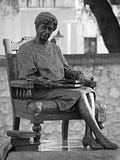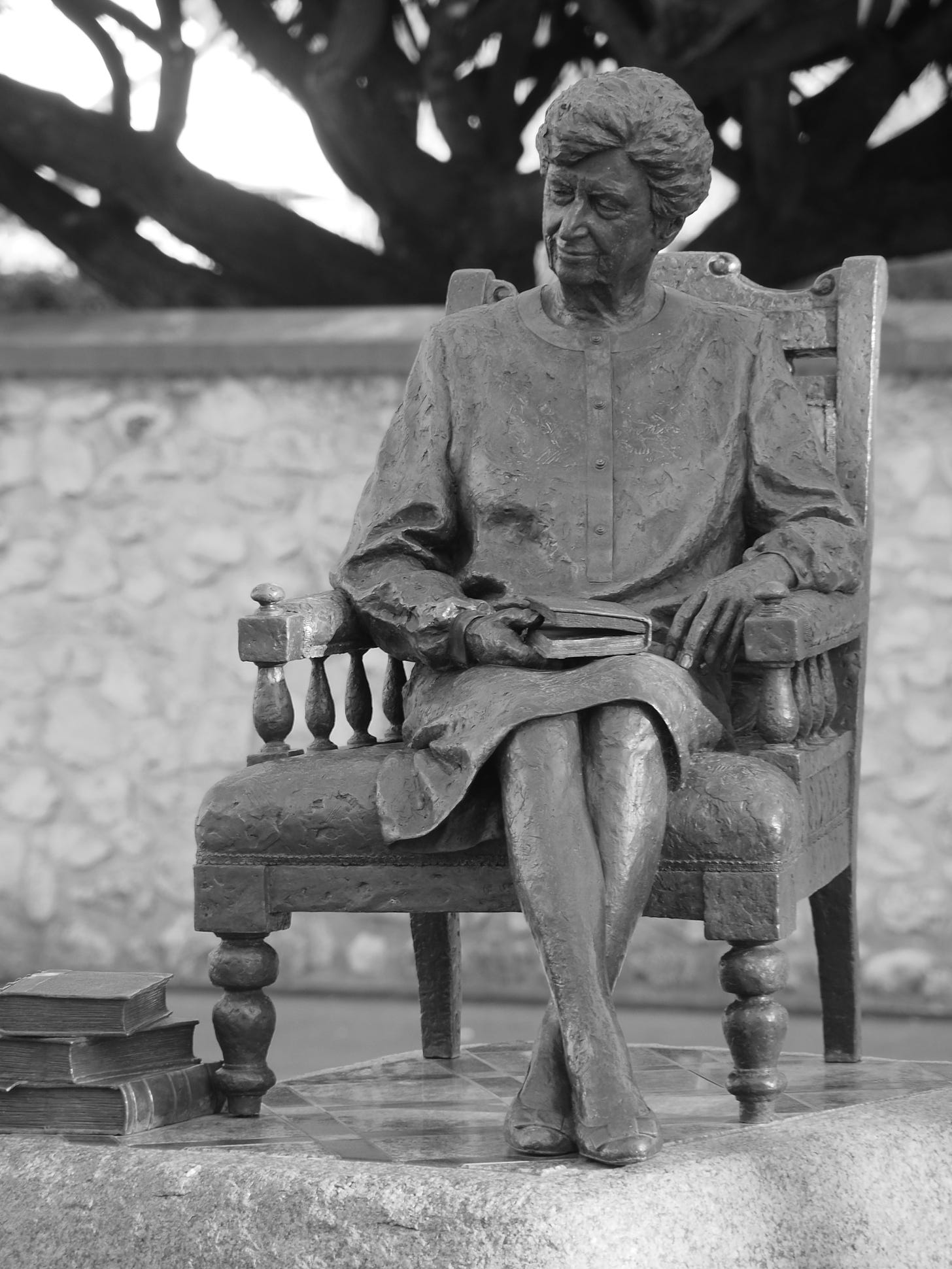Location
Prince Henry Gardens, North Terrace close to the Government House Gates.
Description
Half-life-size bronze figure, seated in a high-backed carved armchair, with books at her feet and a book on her lap. Raised to eye level on a large granite block, inlaid with marble tiles in formal squares. The plinth is faced with fluttering bronze pages which record the title and dedication of the statue, plus a Latin quote “Sapiens Qui Assiduus Est”.
Unveiled 2nd July 1999
Dame Roma Mitchell was only the second woman to be placed on a pedestal in South Australia, after Mary Lee, and the only one to be honoured in her lifetime. Dame Roma had just completed her successful stint as Australia’s first female Governor, with an unruffled grace and the City Council were quick to mark her achievement with the offer of a statue. Further honours ensued with the naming of schools, trusts and a foundation but her bronze tribute sits on Adelaide’s premier boulevard.
Roma Mitchell was a singular figure in the legal world. As a superb scholar she stormed to the bar in 1934, enduring the ossified misogyny of the most conservative profession. Family connections helped her breach the fraternity and from that point, there was no stopping her rise. She became QC in 1962 and the first female Justice of the Supreme Court of South Australia in 1965. Acutely aware of her status as “first” she hoped that she would soon be just one of many, but was always realistic about the challenge.
Never partisan, Dame Roma was respected by both sides of Politics. Progressive, she rode the wave of 1970s liberalization in Australia, chairing the committee for Legal Reform, but took on more political roles such as Royal Commissioner investigating the then explosive dismissal of Police Commissioner Harold Salisbury for obfuscation to the government of the day.
Her fair-minded and matter-of-fact dedication to any task resulted in positions on State and National associations, including the Parole Board, University of Adelaide, Adelaide Festival, Winston Churchill Trust, Aboriginal Legal Rights Review and Human Rights Commission. On her retirement from the bench, she even found time to deliver “meals on wheels.” Her service never ended, made Governor of South Australia from 1991- 1996 and at age 83, appointed Chair of the Ministerial board of the Aging.
Civil orders and titles cascaded. Dame is the female equivalent of a knighthood, which was granted in 1971 as Commander Most Excellent of the Order of the British Empire. Twenty years later, as a flag of changing sentiment, a more progressive Australian Government granted her the country’s highest award as a Companion of the Order of Australia.
A devout Catholic, who rarely missed mass, she was happy in the heart of her small extended family and devoted personal assistants. Dame Roma moved in society easily, but her position and responsibilities placed her far above the crowd. To date, her biographers are hard-pressed to unwrap her personal life. Her workload and public glare probably gave her little opportunity for dalliance but no doubt the private side of her life will be unfolded in the future since her life spans the era of letters and diaries.
Roma Mitchell lived in the heart of Adelaide and in September 1996 the City Council, prompted by councilor, later Lord Mayor Jane Lomax-Smith, submitted a request that she allow a “statue to be constructed of her likeness.” Dame Roma consented, agreeing with the proposed site on North Terrace close to Government House. As a living recipient, she had the rare privilege of stipulating the style and form, preferring casual clothes and a seated pose. Her father’s Latin saying “Sapiens Qui Assiduus Est,’ “he who is industrious is wise,” was added at her request.
The Council granted a generous budget of $100 000, but even so, a life-size figure in bronze was beyond their means. A panel of five sculptors were interviewed, with three invited to submit models, for a judging panel which included representatives from the Public Arts committee and Art Gallery of South Australia. Janette Moore was chosen and proceeded to form the clay figure with Dame Roma modelling in her “favourite chair.”
Difficulties with the clay modelling delayed the work by six months. Tillets, monumental masons, completed the rough granite base and plinth.
The Governor General Sir William Deane unveiled the statue, acknowledging the pleasure of honouring “Adelaide’s favourite daughter” in her presence. Probably to Dame Roma’s discomfort he proclaimed that “she has more significant firsts than any other woman in the history of our nation.” Dame Roma accepted the honour graciously but it was to be one of her last acts, dying at home just a few months later.
Unfortunately, her diminutive statue gives her a childlike presence and fails to capture the spirit and determination that made her a towering figure of her generation. She bore the torch of gender equality but always used it to the betterment of all humankind.
References
ACC Archive U/12/453
ACC Archive 1998-2000, Performance, Monitoring and Compliance committee\Reports\990607_5.1
Magarey S and Round K “Roma the First” Wakefield Press 2007
The Advertiser 3/7/99 p12




